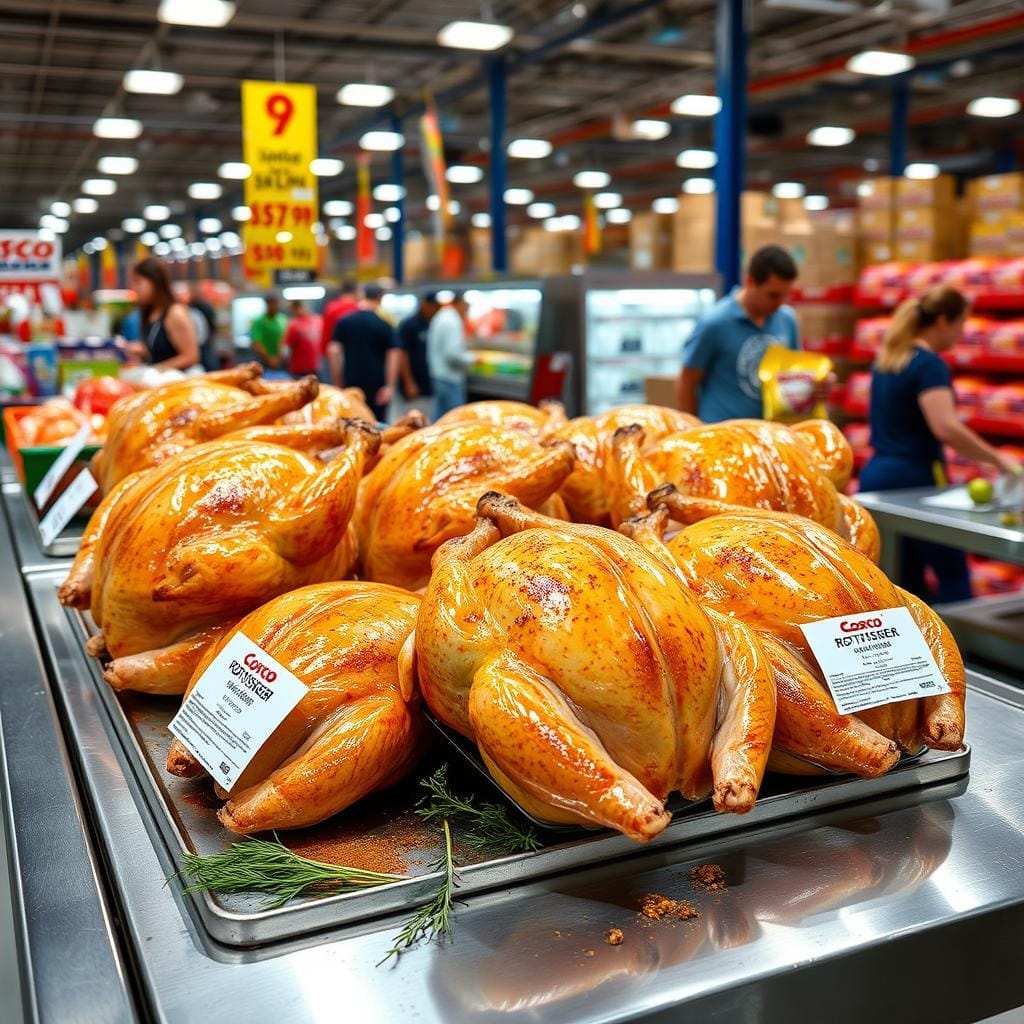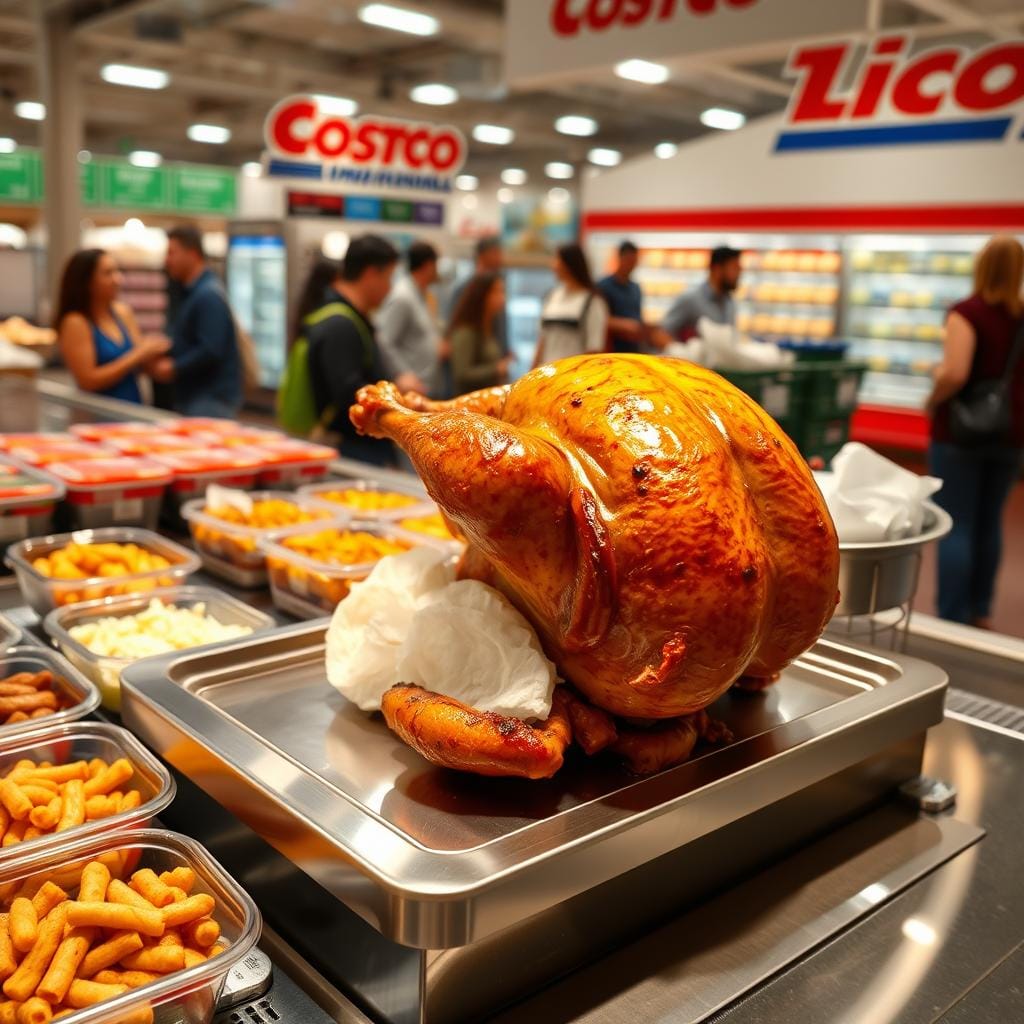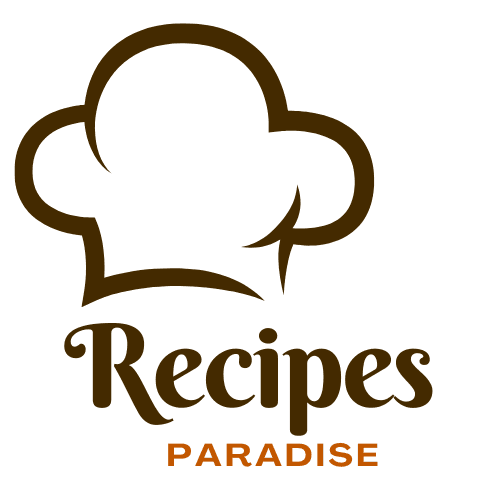Standing in the bustling Costco warehouse, the smell of fresh rotisserie chickens fills the air, making everyone want to buy one. However, have you ever wondered what happens to unsold chickens? In fact, Costco’s rotisserie chicken program is more than just a tasty meal. Instead, it highlights the company’s commitment to sustainability and supporting the community.
Key Takeaways
- The company has a strong plan for unsold rotisserie chickens. They turn them into other products or give them to local food banks.
- The price of Costco’s rotisserie chickens, $4.99, has stayed the same for years. It’s a favorite among shoppers.
- Costco makes sure their prepared foods, like rotisserie chickens, are always fresh and safe. They follow strict temperature and storage rules.
- The company also focuses on being sustainable. They try to use every part of the food they sell.
- Additionally, they work with local groups and donate food to help those in need.
Understanding Costco’s Rotisserie Chicken Program
Costco’s rotisserie chicken program is a true marvel of efficiency. They produce and sell a huge number of chickens every day. This keeps the price at $4.99 for years, attracting many loyal customers.
Daily Production and Sales Volume
Costco sells 100 million rotisserie chickens every year, as CNBC reports. This shows how successful the program is. It also highlights Costco’s skill in managing Costco food waste management and Costco perishable inventory handling.
The $4.99 Price Point Strategy
The $4.99 price for Costco’s rotisserie chicken has stayed the same for years. This price strategy draws in customers and keeps prices low for members. It strengthens Costco’s image as a value-focused retailer.
Quality Control Standards
Costco has strict quality control for its rotisserie chickens. No chicken stays on the shelf for more than two hours. As a result, this prevents harmful bacteria from growing.
Once two hours pass, the chickens are quickly refrigerated. This ensures food safety and keeps customers healthy.

Costco’s whole approach to its rotisserie chicken program shows their dedication. They aim to give members a great, affordable meal every time.
So What Does Costco Do With Unsold Rotisserie Chicken?
Costco is famous for its tasty rotisserie chickens. These chickens sell out quickly. However, what happens to the ones that don’t sell? Costco has a smart plan to reduce waste and make the most of these leftovers.
Costco’s unsold food policy says they remove unsold chickens after two hours. But they don’t just throw them away. Instead, they use the meat for new products like chicken salad and soups.
By saving the chicken, Costco makes money and cuts down on waste. In fact, they sell around 100 million rotisserie chickens each year. And since 2009, they’ve kept the price at $4.99 per chicken.
| Product | Price | Weight |
|---|---|---|
| Whole Rotisserie Chicken | $4.99 | 3 lbs |
| Costco Southwest Rotisserie Chicken Wrap | $6.99 per lb | 1 lb |
The price of a whole chicken is always $4.99. Occasionally, you might find them priced cheaper, around $4.30 or $4.50, which indicates they might be a bit lighter. Nevertheless, at $1.66 per pound, they remain a great deal for Costco members.
Costco is serious about not wasting food. They turn unsold chickens into other tasty items. This way, they make more money and show they care about the planet.

Wondering how you can get creative with rotisserie chicken at home? Check out our Leftover Rotisserie Chicken Recipes for easy and delicious ideas.
Costco’s Food Safety Protocols for Prepared Foods
At Costco, food safety is a top priority, especially for prepared foods like rotisserie chickens. The company has strict protocols to ensure quality and reduce waste.
Temperature Control Requirements
Costco keeps all hot foods, like rotisserie chickens, at 140°F (60°C) to stop harmful bacteria. They monitor and control temperatures closely during production and display.
Storage and Display Guidelines
Costco has specific rules for storing and displaying prepared foods. Rotisserie chickens are in hot cases. Unsold chickens are chilled quickly and sold at a discount to reduce waste.
Time Limits for Hot Food Items
Costco sets strict time limits for hot foods like rotisserie chickens. They are held for up to 2 hours before being sold at a discount or made into other products, like chicken salad.
| Food Safety Measure | Costco’s Requirement |
|---|---|
| Minimum Hot Food Temperature | 140°F (60°C) |
| Maximum Hot Food Holding Time | 2 hours |
| Rapid Chilling for Unsold Items | Yes, to prevent waste |
Costco follows strict food safety rules to make sure its prepared foods, like rotisserie chickens, are safe and tasty. This focus on quality and sustainability is key to Costco’s approach to managing food waste and handling perishables.
Sustainable Practices in Costco’s Food Operations
Costco, a well-known wholesale retailer, is dedicated to sustainable practices in its food operations. Specifically, they focus on Costco sustainability practices and food waste reduction strategies. As a result, this approach helps lessen environmental impact while maintaining high-quality products and services for their customers.
Costco optimizes production schedules for their famous rotisserie chicken. They monitor sales data and adjust production to avoid waste. This way, they manage inventory well and ensure customers get fresh, tasty rotisserie chicken all day.
Costco also repurposes unsold items. Instead of throwing them away, they donate to local food banks and charities. Consequently, this reduces waste and strengthens Costco’s ties with the community, supporting social causes.
“At Costco, we believe that sustainability is not just an option, but a responsibility. Our commitment to reducing waste and minimizing our environmental impact is woven into the fabric of our operations.”
Costco’s commitment to sustainability goes beyond food. They invest in energy-saving technologies and waste reduction efforts. Moreover, they also look for new ways to cut their carbon footprint. By leading in sustainable retail, Costco sets a good example for others to follow.
From Hot Case to Secondary Products
Costco works hard to cut down on food waste, especially with their famous $4.99 rotisserie chickens. When they don’t sell all the chickens, Costco’s team gets to work. They turn these high-quality proteins into many different secondary products.
Creating Ready-Made Meals
Costco’s chefs turn leftover chickens into tasty ready-made meals. You can find dishes like chicken noodle soup or chicken pot pie in the deli section. These meals are easy to grab and go, offering customers a quick and delicious option.
Ingredient Repurposing Process
Costco has a smooth process for using up unsold rotisserie chickens. They carefully take the meat out of the bones. Then, they use it in a variety of deli items, including Costco rotisserie chicken leftovers.
This smart Costco food waste reduction strategy makes sure every part of the chicken is used. It helps cut down on waste and adds value.
Quality Assurance Measures
Costco never compromises on food safety and quality, even with repurposed items. They follow strict rules for temperature, storage, and time. This ensures the secondary products are just as good as the original hot case items.
This focus on quality keeps customers happy and strengthens Costco’s excellent reputation.
By turning unsold rotisserie chickens into secondary products, Costco shows its commitment to Costco food waste reduction strategies. This creative approach not only reduces waste but also gives customers more value. Additionally, it highlights Costco’s dedication to sustainability and customer satisfaction.
Food Donation Programs and Community Partnerships
At Costco, we care about the planet and our communities. We show this by donating food to local food banks and charities. This includes unsold rotisserie chickens and other prepared foods.
Our food donations help reduce waste and feed those in need. We follow strict food safety rules. This ensures the quality and safety of all donated items.
- Costco partners with over 1,000 food banks and community organizations across the United States to donate unsold rotisserie chickens and other prepared foods.
- In 2021 alone, Costco donated more than 80 million pounds of food, including 15 million rotisserie chickens, to local communities.
- Moreover, the company’s donation programs help divert millions of pounds of food from landfills, contributing to its overall sustainability practices.
Costco uses its big supply chain to get food to those who need it. This helps reduce waste and strengthens our community ties. It shows we’re committed to being a good corporate citizen.
Costco’s focus on Costco sustainability practices and helping local communities through Costco chicken donations shows our commitment. By doing this, we set a good example for the retail world. We make a positive difference in people’s lives across the United States.
Looking for another comforting dish to try? This Beefaroni Recipe is a hearty, crowd-pleasing option.
Cost Management and Inventory Control Strategies
At Costco, managing costs and controlling inventory is key. They use advanced systems to track sales and plan production. This helps them predict demand, cut down on overproduction, and reduce food waste.
Sales Tracking Systems
Costco’s sales tracking systems give them real-time data on what customers buy. They watch how well items like the famous rotisserie chicken sell. This helps them guess how much to make and avoid making too much.
Production Scheduling Optimization
Costco uses the data from their sales tracking to plan production better. They adjust their schedules to match what customers want. This way, they can meet demand without wasting food or having too much stock.
These strategies help Costco keep prices low and quality high. Furthermore, they also reduce their environmental impact and cut down on food waste.
Environmental Impact and Waste Reduction Efforts
At Costco, making the planet greener is a big deal. Therefore, the company works hard to cut down on waste. It uses smart packaging and strong recycling programs, which shows it cares about more than just its famous rotisserie chicken.
Costco’s Costco sustainability practices focus on managing food waste well. It keeps an eye on how much food it makes and sells. This way, it reduces the number of rotisserie chickens that go to waste.
Costco also has great recycling programs in its stores. It makes it easy for customers to recycle. This helps local recycling efforts and keeps the environment clean.
“At Costco, we recognize that our responsibility extends beyond the bottom line. We are committed to being a responsible corporate citizen, and our sustainability efforts are a testament to that.”
Costco also works with its suppliers to be more eco-friendly. It helps them use less packaging and find new ways to reduce waste. This makes Costco a leader in reducing its carbon footprint and helping the planet.
Costco’s strong commitment to being green is an inspiration to others. It shows that big companies can make a big difference. Costco’s efforts encourage others to follow, making the future look brighter for our planet.
Chicken Salad and Other Value-Added Products
At Costco, they go beyond just selling rotisserie chickens. They turn unsold chickens into tasty products like chicken salad. This way, they make sure every chicken is used well, keeping quality and safety in mind.
In-House Processing Methods
Costco uses advanced facilities to process leftover chicken meat. They debone, shred, and mix it with special seasonings. This makes the Costco chicken salad a hit with customers, who trust its quality.
Product Line Development
Costco’s team is always looking for new ways to use leftover chicken. They’ve added chicken noodle soup, pot pie, and sandwiches to their menu. This variety meets different tastes and cuts down on waste, making every chicken count.
Costco’s efforts to reduce food waste are clear in their approach. They turn leftover chicken into tasty meals. As a result, this not only cuts down on waste but also gives customers more choices for quick, quality meals.
Craving bold flavors? Transform your dinner with our Boulders Enchilada Recipe, perfect for any occasion.
Conclusion
Costco is dedicated to reducing waste and helping the community. They turn unsold rotisserie chickens into different meals and deli items. This way, they keep the price low at $4.99, attracting many customers.
The company manages its inventory well, keeping food from going to waste. They also donate to those in need. This shows Costco’s effort to be sustainable and make a difference.
Costco’s focus on quality and affordability is impressive. They manage their unsold chickens well, showing care for the environment. This balance is a great example for others in the industry.
FAQ
What does Costco do with unsold rotisserie chickens?
Costco has several ways to deal with unsold rotisserie chickens. They use the meat for chicken salad and donate food to those in need. They follow strict food safety rules to keep products safe and fresh.
How does Costco’s rotisserie chicken program work?
Costco makes and sells a lot of rotisserie chickens every day. They keep the price at .99 to attract customers. They check the quality of each chicken to make sure it’s good.
They use systems to track sales and plan production. This helps them manage how much chicken they make and sell.
What are Costco’s food safety protocols for prepared foods?
Costco follows strict rules to keep prepared foods, like rotisserie chickens, safe. They control the temperature and how the chickens are stored and displayed. They also have time limits for hot foods.
These steps help keep the food safe and of good quality. They also help reduce waste.
How does Costco implement sustainable practices in its food operations?
Costco works hard to reduce waste and protect the environment in its food operations. They optimize production and find new uses for unsold items. They also donate to local food banks.
These efforts help cut down on waste. They also make sure the food is still good and that customers are happy.
How does Costco create value-added products from unsold rotisserie chickens?
Costco turns unsold rotisserie chickens into new products like ready-made meals and chicken salad. They carefully choose ingredients and check the quality. This way, they reduce waste and offer more products to customers.
How does Costco manage costs and control inventory for its rotisserie chicken program?
Costco uses advanced systems to manage costs and keep inventory in check. They track sales and plan production to avoid making too much chicken. This helps them predict demand and cut down on waste.
They can adjust production based on sales data in real-time. This keeps costs low and inventory under control.

1 thought on “What Does Costco Do With Unsold Rotisserie Chicken? A Behind-the-Scenes Look”